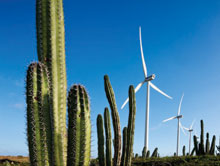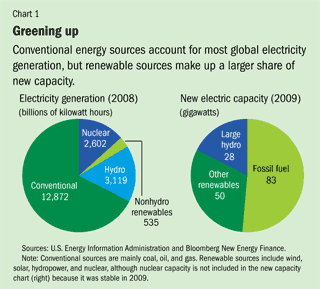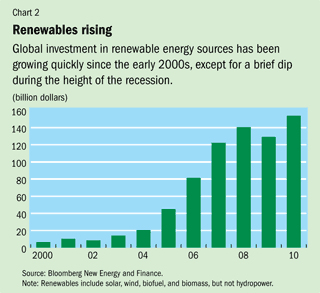Going Green
Finance & Development, June 2012, Vol. 49, No. 2
Luc Eyraud and Benedict Clements
Investment in environmentally friendly technologies is growing globally
 CLIMATE change is one of the most pressing challenges facing the planet. Man-made greenhouse gas emissions from fossil fuel combustion and changes in land use are the predominant causes. The emission of greenhouse gases leads to global warming, smog, and acid rain and adversely affects public health. Several studies point to potentially catastrophic outcomes for humans if greenhouse gas emissions are not reduced (Stern, 2007).
CLIMATE change is one of the most pressing challenges facing the planet. Man-made greenhouse gas emissions from fossil fuel combustion and changes in land use are the predominant causes. The emission of greenhouse gases leads to global warming, smog, and acid rain and adversely affects public health. Several studies point to potentially catastrophic outcomes for humans if greenhouse gas emissions are not reduced (Stern, 2007).
But climate change has more than environmental and health consequences. There are likely to be important economic effects as well, given the far-reaching impact of higher temperatures, rising sea levels, and extreme weather conditions on output and productivity. Moreover, climate developments will likely disrupt governmental fiscal positions both through reduced tax revenues and from spending programs—importantly, through the costly policies needed to mitigate climate change and adapt behavior and production to the new environment (IMF, 2008a and 2008b). These costs and risks point to the unsustainability of current patterns of energy use, but the transition to a low-carbon-emission model will require large investments in alternative, so-called green, energy sources.
For all the importance given to boosting green investment, however, surprisingly little research has been done on the topic. The concept is relatively new and not precisely defined in the economic literature. Furthermore, data are scarce and scattered among various sources. We try to fill this gap by proposing a definition of green investment and analyzing its trends and macroeconomic determinants over the past decade in advanced and emerging economies. The results provide powerful insights for policymakers seeking to move toward a more green economy.
Investing green
There is no standard definition of green investment. We define it as the investment necessary to reduce greenhouse gas and air pollutant emissions significantly. There are several ways to reduce gas emissions, and thus green investment may take various forms:
• Investments that make energy generation less polluting. Green investment involves shifting energy supply from fossil fuels to less-polluting alternatives—either as sources of electricity generation (such as wind, solar, nuclear, hydropower) or as direct sources of energy (for example, a biofuel such as ethanol made from corn or sugarcane). The green investment concept extends not only to emerging environmental technologies, such as wind and solar photovoltaic power, but to more established technologies like nuclear and hydropower. To retain a simple distinction between energy from fossil fuels and energy from low-emission alternatives, our green investment concept includes investment in nuclear power. Some have argued that because it produces radioactive waste, nuclear power should be excluded from any green spending concept. However, we include it because our definition is based on the impact of the investment on gas emissions. Biofuels are also part of our definition of green investment. Despite their debatable impact on carbon emissions, they are a renewable energy source and thus are considered green in our analysis.
• Investments that reduce energy consumption. Green investment also includes technologies that reduce the amount of energy required to provide goods and services, which increases energy efficiency. In the electricity sector, there is room to improve efficiency in power generation (by moving to supercritical coal-fired plants, which are highly efficient electricity plants that burn less coal) and in transmission and distribution (by using more efficient grids, for instance). There is also potential for efficiency gains in transportation—by using more fuel-efficient and hybrid cars and by increasing use of mass transit. In industrial equipment, efficiency gains can be achieved through energy-saving appliances and improved waste management. In construction, efficiency can be enhanced through improved insulation and cooling systems.
From brown to green energy sources
Green technologies (nuclear and renewable, such as solar, wind, and hydropower) already play an important role in electricity production. In 2008, about one-third of global electricity was generated from nuclear and renewable sources and two-thirds from conventional, or brown, sources such as coal, gas, and oil (see Chart 1, left). These shares have been relatively stable over time. However, since the second half of the 1990s, green energy generation has shifted from hydro and nuclear power to other renewables. These other renewable technologies have significantly contributed to the buildup of electric capacity in recent years. For instance, they accounted for about one-third of the capacity increase in 2009 (see Chart 1, right).

Over the past decade, many public programs have been put in place—mostly in the advanced and emerging economies that are members of the Organization for Economic Cooperation and Development—to encourage the production or consumption of renewable energy. The number of countries with some type of policy target or support policy almost doubled in recent years—from 55 in early 2005 to more than 100 by early 2010.
Support plans generally have three main goals: reduce carbon emissions and prevent climate change; improve energy security by diversifying the energy mix; and foster growth by promoting competitiveness, job creation, and innovation in new industries.
The most common forms of support policies for renewable electricity generation are feed-in tariffs (adopted by 50 countries and 25 states or provinces as of early 2010) and renewable portfolio standards (found in 10 countries and 46 states or provinces). Feed-in tariffs mandate that utility companies pay prices to green electricity producers that reflect the cost of the technology, which can be above the cost of conventional electricity generation. Renewable portfolio standards require electricity companies to rely on renewables for some fraction of their energy sources.
Estimating the cost of public programs is tricky. They include not only direct payments but also tax breaks, loan guarantees, and quotas. Published estimates suggest that worldwide public programs cost between $40 billion and $60 billion a year. Biofuel subsidies account for most of the public spending costs.
Several of these public programs were scaled up as part of the fiscal policy response to the global financial crisis. Support for clean energy, pledged as part of fiscal stimulus plans, amounts to about $180 to $195 billion, primarily from three countries: the United States ($65 billion), China ($46 billion), and Korea ($32 billion). In the countries with the largest green packages, green measures represent no more than 15 percent of the total fiscal stimulus, except in Korea, where 80 percent of the stimulus has been earmarked for green investment. Only half of the total allocated funds, however, was disbursed in 2009 and 2010. Implementation of green stimulus financing has been slowed by the complex planning and processing required for releasing public funds. In addition, countries facing large public sector deficits have scaled down green spending.
Investment boom in renewable technologies
Investment in renewable energy—solar, wind, biofuels, biomass, and geothermal heat (excluding hydropower projects)—has risen substantially during the past decade, with most of the increase occurring after 2004. Between 2000 and 2010, renewable green investment increased from $7 billion a year to $154 billion (see Chart 2). The increase is due to a number of factors, including global economic growth, increasing prices of fossil fuels, technology advances, policy support, and increasing citizen demand for a cleaner environment. A reduction in the cost of adopting green technologies has also been realized through economies of scale, technological progress, and lower interest rates. Renewable green investment temporarily declined during the global recession in 2009 because of less favorable financial conditions and uncertainty over future demand for green energy as fossil fuel prices receded. This decline could have been greater, but the falloff in private investment was mitigated by support from measures taken as part of fiscal stimulus programs.

Renewable green investment has now become a global phenomenon. It grew steadily in all major regions until the onset of the economic crisis. From 2004 to 2010, Europe and North America quadrupled their investment, while Asia and Oceania increased renewable green investment tenfold. At present, North America, Europe, and Asia are the largest markets, but the regional composition has changed dramatically in recent years. Leadership in spending shifted from Europe to Asia, reflecting, to a large extent, differences in economic performance. The European and North American share of global green investment fell to 46 percent in 2010, from 68 percent in 2004, while Asia and Oceania’s share increased from 28 percent to 42 percent.
Green investment in Asia continued to soar during the global financial crisis, with China accounting for the bulk of the growth. In 2009, China had the highest investment of any country in renewables and in 2010 invested more in renewable energy than all of Europe. Through a series of new laws and financial support measures (including loans from state-owned banks), the Chinese government has encouraged large renewable energy projects, with a view to promoting domestic manufacturing and improving energy security. China is now the world leader in the production of photovoltaic modules and wind power equipment. China has also stepped up its research and development efforts and leads in clean technology patents and initial public offerings by companies in the renewables sector.
Nuclear and hydropower inertia
Global nuclear capacity grew rapidly during the 1970s and 1980s, but interest waned following the Chernobyl disaster of 1986. As a result, nuclear power’s share of total electricity generating capacity had declined from about 12 percent in 1990 to 8 percent in 2008. Even before the nuclear incident in Japan in 2011 following the earthquake and tsunami, a number of obstacles had kept the industry from expanding. These include increasing construction costs, fewer workers with the necessary specialized skills, insufficient grid capacity, environmental worries, and concerns about safety and nuclear proliferation. Asia now drives growth in nuclear capacity. The number of nuclear reactors under construction in Europe and North America decreased from 159 in 1980 to 20 in 2010. By contrast, 42 new reactors are under construction in Asia.
Hydropower, which harnesses the energy of falling water, is the largest source of renewable-based electricity. Global hydropower capacity has been growing steadily, aided by relatively inexpensive construction costs compared with its alternatives. Nonetheless, hydropower’s share of total electricity capacity declined from 23 percent in the early 1980s to 19 percent in 2008. Environmental regulations and stagnation in technological advances have slowed expansion in industrialized countries, where many of the best sites for hydropower have already been exploited. Over the past decade, capacity growth has been the strongest in Asia, averaging 12 percent a year, while in Europe and North America growth has averaged about 1.5 percent. China has been the most dynamic market, nearly doubling its hydropower capacity during 2004–09.
How to boost green investment
The economic literature on climate change has largely overlooked the macroeconomic determinants of green investment. We fill this gap using data on renewables investment in 35 advanced and emerging economies during 2004–10 (Eyraud and others, 2011). Almost all green investment in the world takes place in these 35 countries.
We adopted a statistical approach to identify the main factors affecting green investment and assess their relative impact. We tested the significance of a large set of macroeconomic variables, and five stood out as statistically significant in determining the level of green investment: real gross domestic product (GDP), the long-term real interest rate, the relative price of international crude oil, a variable representing the adoption of feed-in tariffs, and a variable measuring whether a country has a carbon pricing mechanism (carbon tax or cap-and-trade). These are some of our findings:
• Higher levels of GDP tend to boost investment in green technologies. Economic activity raises the demand for energy and investment in the energy sector. In addition, at higher levels of development, structural change toward information-intensive industries and services, international relocation of manufacturing industries, increased environmental awareness, and better enforcement of environmental regulations result in larger environmental expenditures and a gradual decline in environmental degradation. We find that an additional 1 percentage point of GDP growth should raise green investment growth by about 4 percentage points in the long run, other factors being equal.
• The cost of capital—proxied by the long-term real interest rate—has a negative impact on green investment. The estimated effect is quite large: green investment declines by about 10 percent when the real interest rate increases by 1 percentage point. Research on general business investment finds that investment is relatively insensitive to interest rates. But green investment seems to be very responsive to interest rate movements. This result, which is well documented in descriptive studies, is not surprising given that renewable projects use a lot more capital than labor and rely mostly on external financing.
• Oil prices also have a positive and large impact on green investment. Indeed, higher fuel prices increase the return on green investment by lowering the cost of the electricity produced from renewables relative to that generated through fossil fuel combustion. We estimate that green investment grows by an additional percentage point when there is a 1 percentage point difference between increases in crude oil prices and economy-wide inflation.
• Renewable portfolio standards and biofuel mandates do not seem to affect green investment. In the case of biofuel mandates, this is probably related to the fact that investment in biofuel has declined significantly since 2007 due to high feedstock prices and overcapacity. In contrast, feed-in tariffs have a strong effect. This result supports the view that feed-in tariffs are one of the most important instruments supporting the expansion of renewables. Based on our estimation, green investment should be two to three times larger in countries adopting feed-in tariffs, other factors being equal. The effect of carbon pricing plans (in the form of an environmental tax levied on the carbon content of fuels, for instance) is also significant in almost all specifications.
Overall, our results show that green investment can be powerfully influenced by public policies. Interest rates and macroeconomic factors such as economic growth matter, but so do energy policies. Green investment increases when its cost, relative to traditional fossil fuel technologies, is reduced by higher oil prices. It can be powerfully influenced by public policies. Specific public interventions to support green investment can also be useful. The statistical results suggest that feed-in tariffs and carbon pricing mechanisms tend to support green investment. Many policies, however, do not seem to be effective, including support for biofuels. This adds to concerns regarding the effectiveness of biofuel subsidies and their adverse effects on the food supply (IMF, 2008c).
Where does it go?
Green investment has become a global phenomenon and a key driver of the energy sector. At the same time, the regional composition has changed dramatically in recent years. Asia, led by China, is increasingly important. China became the country with the highest investment in renewables in 2009 and has invested more in renewable energy than Europe as a whole in 2010. Our results also underscore that there is much countries can do to catalyze green investment. In particular, providing the right incentives for investments in alternatives—including the appropriate pricing of fossil fuel products and carbon emissions—will be key for moving toward a more green economy.■
Luc Eyraud is an Economist and Benedict Clements is a Division Chief, both in the IMF’s Fiscal Affairs Department.
References
Eyraud, Luc, Abdoul Wane, Changchang Zhang, and Benedict Clements, 2011, “Who’s Going Green and Why? Trends and Determinants of Green Investment,” IMF Working Paper 11/296 (Washington: International Monetary Fund).
International Monetary Fund (IMF), 2008a, “Climate Change and the Global Economy,” World Economic Outlook, Chapter 4 (Washington, April).
———, 2008b, “The Fiscal Implications of Climate Change” (Washington, March). www.imf.org/external/np/pp/eng/2008/022208.pdf
———, 2008c, “Fuel and Food Price Subsidies—Issues and Reform Options” (Washington, September). www.imf.org/external/np/pp/eng/2008/090808a.pdf
Stern, Nicholas, 2007, The Economics of Climate Change: The Stern Review (London: Cambridge University Press).


